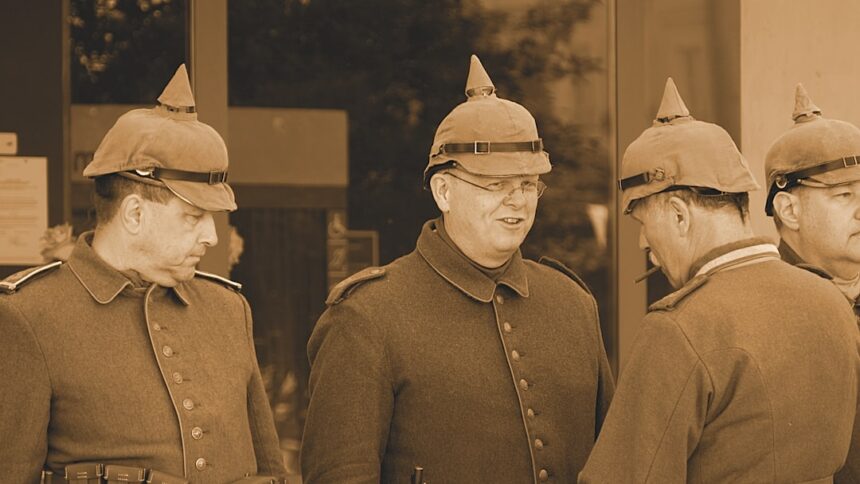During World War II, espionage played a pivotal role in shaping the strategies and outcomes of the conflict. Germany, under the leadership of Adolf Hitler, invested heavily in intelligence operations, seeking to gather crucial information about enemy movements and plans. The German intelligence apparatus, primarily orchestrated by the Abwehr, was tasked with infiltrating enemy territories and gathering intelligence that could provide a strategic advantage.
This period saw a surge in espionage activities, with spies operating in various countries, including the United States, where they aimed to undermine the war effort from within. The stakes were incredibly high, as both the Axis and Allied powers recognized that information could be as powerful as weaponry. The German espionage efforts were characterized by a mix of traditional spying methods and innovative tactics, reflecting the urgency of the times.
As the war progressed, the effectiveness of these operations would be tested, leading to significant consequences for those involved. The story of six German spies who infiltrated the United States serves as a compelling case study of the risks and repercussions associated with espionage during this tumultuous period.
Key Takeaways
- German espionage during World War II was a significant aspect of the war effort, with spies being sent to various countries, including the United States.
- The six German spies sent to the United States had specific missions, including gathering intelligence, sabotage, and spreading propaganda to support the German war effort.
- The capture and interrogation of the German spies by the FBI led to the unraveling of their espionage network and the thwarting of their plans.
- The trial and execution of the German spies garnered significant attention and had a profound impact on the war effort, serving as a deterrent to other potential spies.
- The legacy of the German spies’ execution in espionage history is a reminder of the risks and consequences of engaging in espionage activities during wartime.
The six German spies and their mission in the United States
In 1942, six German spies were dispatched to the United States with a singular mission: to sabotage American war efforts and create chaos within the country. These men, who had been trained in various espionage techniques, arrived on American shores with plans to disrupt factories, transportation systems, and other critical infrastructure. Their mission was not only to gather intelligence but also to instigate fear and uncertainty among the American populace.
The spies were equipped with explosives and detailed instructions on how to carry out their sabotage operations effectively. Upon their arrival, the spies quickly realized that executing their plans would be more challenging than anticipated. The vastness of the American landscape and the complexity of its industrial operations posed significant obstacles.
However, their activities did not go unnoticed, and it soon became clear that their presence in the United States would have dire consequences.
The capture and interrogation of the German spies

The fate of the six German spies took a dramatic turn when they were apprehended by American authorities. Their capture was largely due to a combination of luck and vigilance on the part of law enforcement agencies. One of the spies, George John Dasch, had a change of heart and decided to surrender to the FBI, providing crucial information about his fellow operatives.
This act of defection not only led to the swift capture of the remaining spies but also opened up a window into their plans and objectives. Interrogation sessions revealed a wealth of information about German espionage tactics and strategies. The captured spies were subjected to intense questioning, during which they divulged details about their training, mission objectives, and contacts within the United States.
The intelligence gathered from these interrogations proved invaluable for American military and intelligence agencies, allowing them to thwart potential sabotage operations and tighten security measures across critical infrastructure.
The trial and execution of the German spies
| Spies | Outcome | Location | Date |
|---|---|---|---|
| Carl Hans Lody | Executed by firing squad | Tower of London, UK | November 6, 1914 |
| Augusto Alfredo Roggen | Executed by firing squad | Tower of London, UK | November 17, 1915 |
| Franz von Rintelen | Imprisoned in the US | United States | 1917 |
Following their capture, the six German spies were put on trial in a military tribunal. The proceedings were swift and marked by a sense of urgency, reflecting the heightened tensions of wartime America.
The evidence against them was overwhelming, including confessions from Dasch and corroborating testimonies from other captured operatives. Ultimately, all six spies were found guilty and sentenced to death. Their execution was carried out on August 8, 1942, just weeks after their capture.
This swift justice was intended to send a clear message: espionage would not be tolerated during wartime. The executions were met with mixed reactions; while many Americans viewed them as necessary for national security, others questioned the fairness of the military tribunal process.
Impact of the German spies’ execution on the war effort
The execution of the six German spies had a profound impact on American morale and wartime strategy. It served as a stark reminder of the real threats posed by enemy operatives within the country. The swift resolution of their case bolstered public confidence in government efforts to protect national security.
Additionally, it highlighted the importance of counterintelligence measures, prompting American authorities to enhance their surveillance and security protocols. Moreover, the executions had a chilling effect on potential collaborators within the United States. The fear of severe repercussions for espionage activities discouraged many from considering similar paths.
This shift in public sentiment contributed to a more unified home front as Americans rallied around their government in support of the war effort. The message was clear: those who sought to undermine the nation would face dire consequences.
The legacy of the German spies’ execution in espionage history

The legacy of the German spies’ execution extends beyond their individual cases; it represents a significant chapter in the history of espionage during World War
In addition to its immediate implications for wartime policy, this episode also influenced post-war intelligence operations. The lessons learned from interrogating these spies informed future counterintelligence strategies employed by both American and Allied forces. As nations emerged from the war, they recognized that effective intelligence operations required not only gathering information but also understanding adversaries’ motivations and tactics.
Comparison of German espionage tactics with those of other countries during World War II
German espionage tactics during World War II were characterized by a blend of traditional methods and innovative approaches that set them apart from those employed by other nations involved in the conflict. While many countries relied on conventional spying techniques—such as human intelligence gathering through agents or informants—Germany’s approach often involved more aggressive tactics aimed at direct sabotage and disruption. In contrast, Allied powers like Britain and the United States focused heavily on counterintelligence efforts to thwart enemy operations rather than solely relying on offensive espionage tactics.
For instance, British intelligence developed sophisticated methods for intercepting communications and decoding enemy messages, which proved invaluable in gaining insights into German plans. This difference in approach highlighted varying philosophies regarding intelligence operations during wartime.
The role of double agents in thwarting German espionage efforts
Double agents played a crucial role in undermining German espionage efforts throughout World War
One notable example is Juan Pujol García, known as “Garbo,” who successfully deceived German intelligence into believing he was providing valuable information while actually feeding them false data. His efforts helped mislead Germany about Allied invasion plans, ultimately contributing to the success of D-Day. Such double agents exemplified how subterfuge could be wielded as a powerful weapon against enemy espionage activities.
The use of propaganda to portray the executed German spies as heroes in Nazi Germany
In Nazi Germany, propaganda played an essential role in shaping public perception regarding various aspects of the war, including espionage activities. Following the execution of the six spies in America, Nazi officials sought to portray them as martyrs who had bravely sacrificed themselves for their country’s cause. This narrative was designed to inspire loyalty among citizens and reinforce support for Germany’s military objectives.
The regime utilized state-controlled media outlets to disseminate stories that glorified these individuals’ actions while framing their capture and execution as an affront to German honor. By casting them as heroes rather than criminals, Nazi propaganda aimed to rally public sentiment around continued support for espionage efforts abroad—despite their failures—and maintain morale on the home front during challenging times.
The espionage techniques and strategies employed by the German spies
The espionage techniques employed by the six German spies reflected a combination of traditional methods and innovative strategies tailored for their mission in America. They utilized covert communication methods to relay information back to Germany while attempting to establish networks within sympathetic communities. Their training included sabotage techniques that involved explosives designed to disrupt critical infrastructure such as factories and transportation hubs.
Additionally, these spies relied on disguises and false identities to navigate American society without arousing suspicion. They often sought out individuals who might share their ideological beliefs or who could be persuaded to assist them in their sabotage efforts. However, despite their training and preparation, many aspects of their mission were hampered by unforeseen challenges—such as cultural differences and an underestimation of American law enforcement capabilities.
The significance of the German spies’ execution in shaping post-war intelligence operations
The execution of the six German spies marked a turning point not only in American wartime policy but also in shaping post-war intelligence operations globally. It underscored the necessity for nations to develop robust counterintelligence frameworks capable of identifying threats before they materialized into significant risks. As countries emerged from World War II, there was an increased recognition that effective intelligence operations required collaboration among various agencies—both domestically and internationally.
Furthermore, this episode highlighted how public perception could influence intelligence operations; governments learned that maintaining public support was crucial for successful counterintelligence initiatives. As nations navigated the complexities of post-war geopolitics, lessons drawn from this chapter in espionage history informed strategies aimed at preventing future threats while fostering cooperation among allied nations in an increasingly interconnected world. In conclusion, the story of German espionage during World War II is one marked by intrigue, danger, and significant consequences for those involved.
The actions taken by these six spies not only impacted their own fates but also reverberated throughout history, shaping future intelligence operations and highlighting the delicate balance between national security and individual rights during times of conflict.
In the annals of World War II espionage, the execution of six German spies in the United States stands as a stark reminder of the high stakes involved in wartime intelligence operations. These individuals, caught and tried for their clandestine activities, were part of a larger network of espionage that sought to undermine the Allied efforts. For a deeper understanding of the context and implications of such wartime espionage, you can explore a related article on the topic by visiting In The War Room. This resource provides insights into the broader strategies and counterintelligence measures employed during the war, shedding light on the complex world of wartime espionage.
WATCH THIS! 😱The Nazi Trial America Never Wanted You To See 😱
FAQs
What were the names of the six executed German spies?
The six executed German spies were George John Dasch, Ernst Peter Burger, Herbert Haupt, Heinrich Harm Heinck, Edward Kerling, and Richard Quirin.
When were the six German spies executed?
The six German spies were executed on August 8, 1942, during World War II.
Where were the six German spies executed?
The six German spies were executed in the electric chair at the District of Columbia Jail in Washington, D.C.
What were the charges against the six German spies?
The six German spies were charged with espionage, sabotage, and violation of the laws of war.
What was the outcome of the trial of the six German spies?
All six German spies were found guilty and sentenced to death by a military tribunal.
What impact did the execution of the six German spies have on World War II?
The execution of the six German spies was a significant event in World War II as it demonstrated the United States’ commitment to combating espionage and sabotage on its soil. It also served as a deterrent to potential enemy agents.




